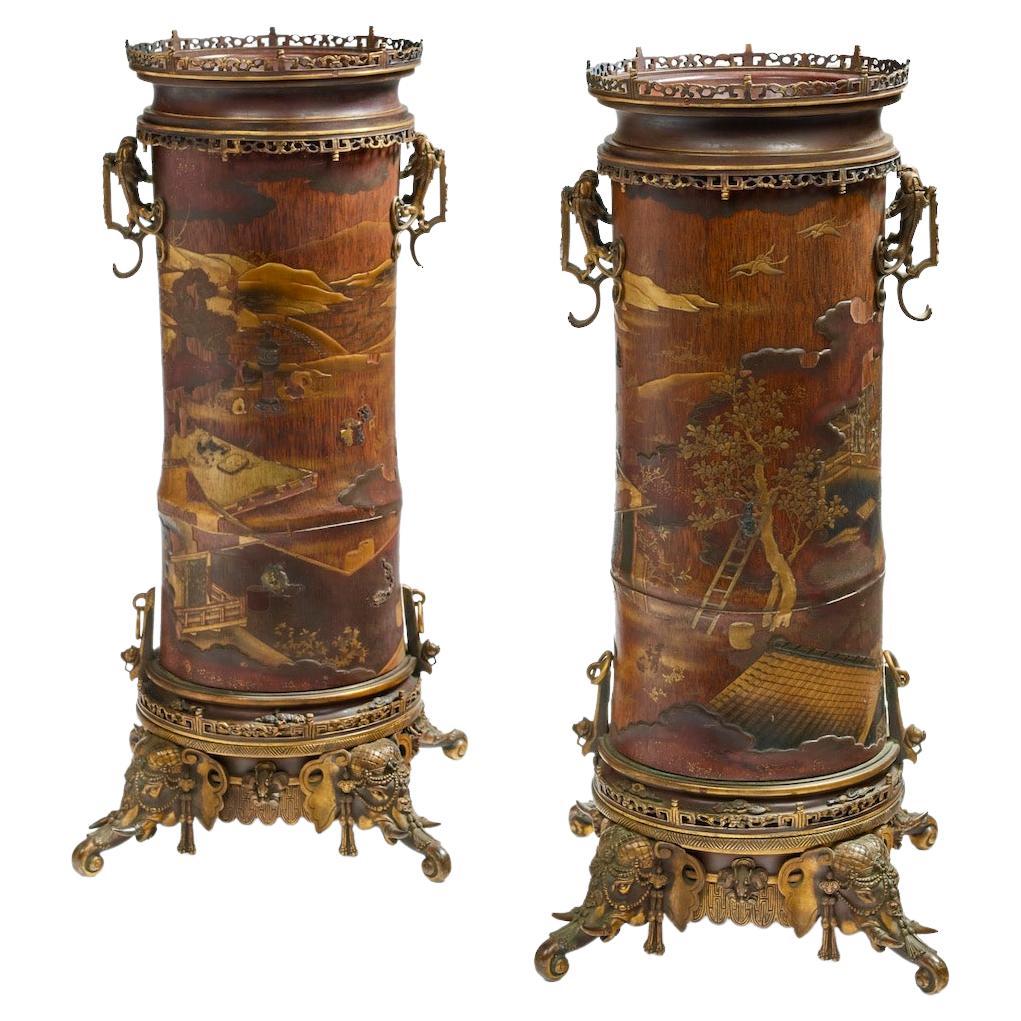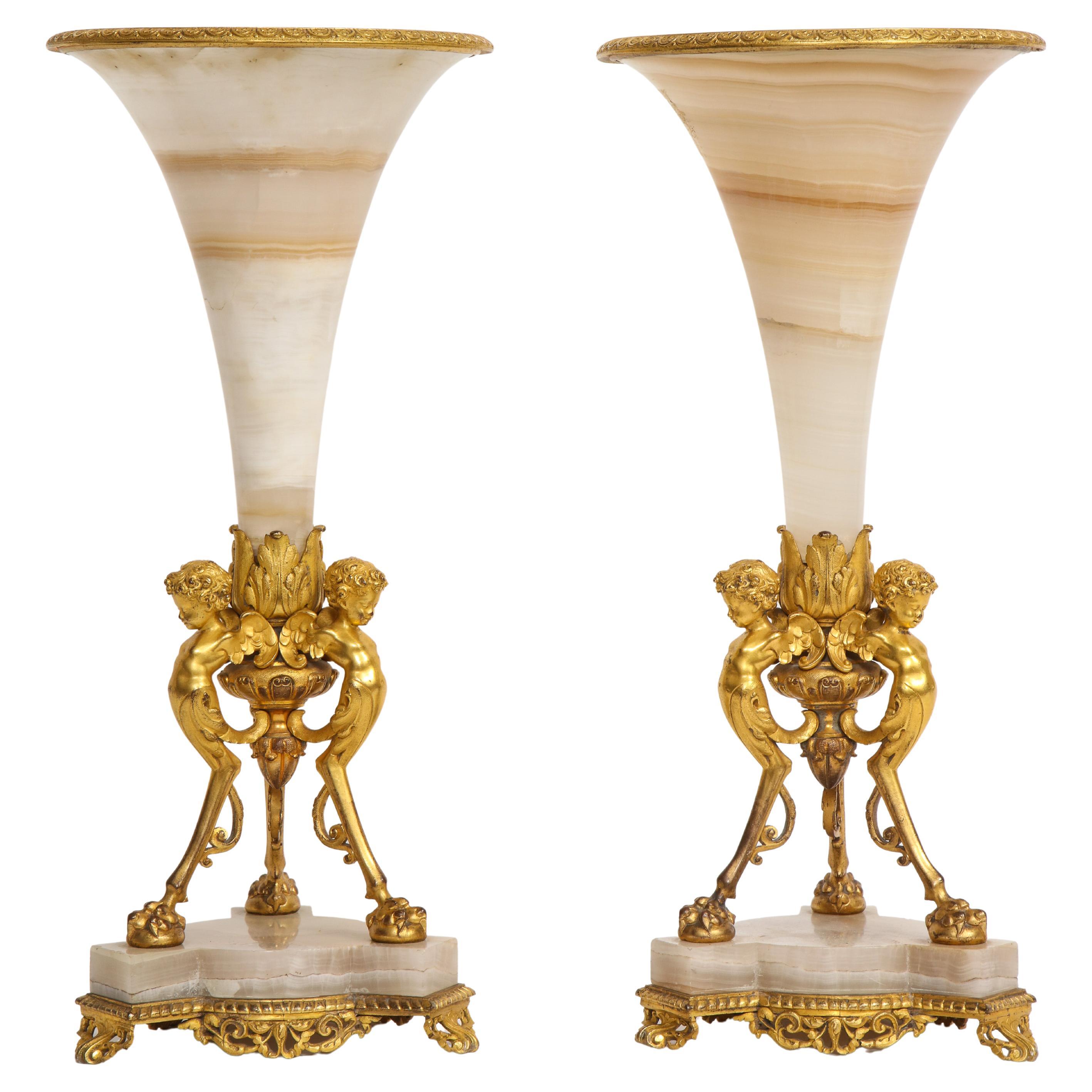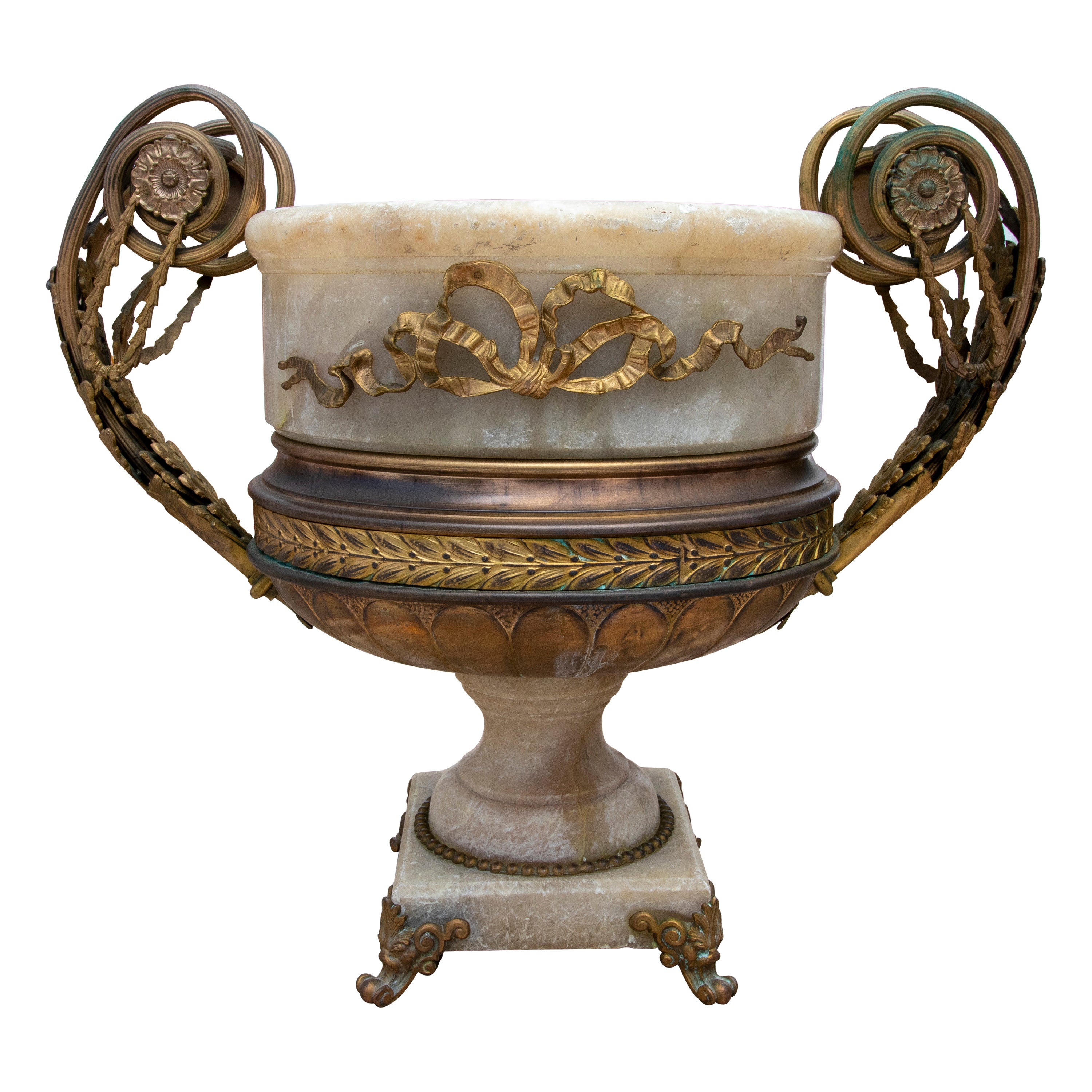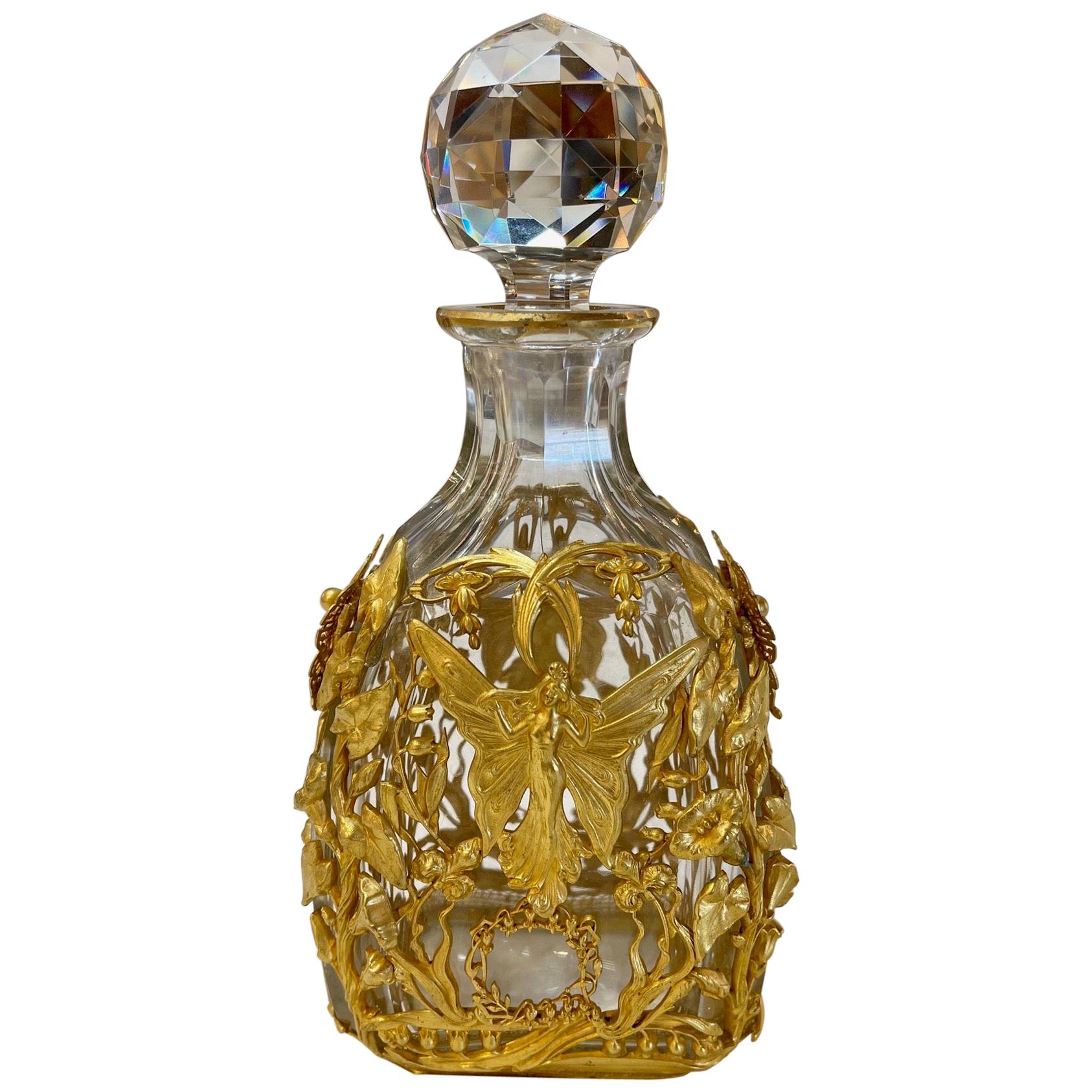Items Similar to Mid 19th c. Early French Silvered & Dore Bronze With Honey Alabaster Vase
Want more images or videos?
Request additional images or videos from the seller
Mid 19th c. Early French Silvered & Dore Bronze With Honey Alabaster Vase
About the Item
For those with discriminating taste for French antiques, this 19th century French Silvered and Dore Bronze with Honey Alabaster vase is nothing short of magnificent! Created in the style of Edouard Lievre, this vase is masterfully crafted with cast bronze with areas that have been silvered to showcase the intricate detail and texture. The side handles are silvered bronze with wreath hangers. At the base of the honey alabaster stone vase is a cherub face with silvered leaf head ring as well as silvered leaf foliage on either side. The base is attached with intricate scrolls attached to an ornately detailed base finished with a clawed foot.
We do not disturb vintage silver or bronze items in order to keep their original patina. Polishing is left up to the buyer.
- Similar to:Edouard Lievre (Designer)
- Dimensions:Height: 10 in (25.4 cm)Width: 6.5 in (16.51 cm)Depth: 6 in (15.24 cm)
- Style:Empire (Of the Period)
- Materials and Techniques:
- Place of Origin:
- Period:
- Date of Manufacture:1850's
- Condition:Wear consistent with age and use. This gorgeous piece shows patina and wear consistent with a piece of this age.
- Seller Location:Louisville, KY
- Reference Number:
About the Seller
No Reviews Yet
Vetted Seller
These experienced sellers undergo a comprehensive evaluation by our team of in-house experts.
Established in 2023
1stDibs seller since 2023
7 sales on 1stDibs
Typical response time: <1 hour
- ShippingRetrieving quote...Ships From: Louisville, KY
- Return PolicyThis item cannot be returned.
More From This SellerView All
- Early 19th Century Bronze French Grand Tour Urns (Pair)Located in Louisville, KYThis pair of early 19th century Grand Tour Period bronze gilt volute krater urns on stone bases are absolutely breathtaking. The base is a heavy black slate with etched Neo-classic f...Category
Antique Early 19th Century French Grand Tour Urns
MaterialsStone, Slate, Bronze
- 19th Century French Bronze Metal and Crystal Urn, Pair, attributed to BaccaratBy BaccaratLocated in Louisville, KYThe 19th Century French artisans knew how to design lasting classical beauty. This extraordinary pair of French urns is proof of the mastery put forth in design and construction. Fro...Category
Antique 19th Century French Empire Urns
MaterialsCrystal, Bronze
- 19th Century French Neo-Classic Spelter, Gilt, Bronze Cherub and Rams Head EwerLocated in Louisville, KYThis ewer is a stunning decorator item! The attention to detail from this era is nothing short of exquisite. From the beautiful cherub that adorns the handle to the rams heads, every...Category
Antique Late 19th Century French Neoclassical Urns
MaterialsBronze
- 19th Century Primitive Dove Tailed Hammered Copper Brass Water JugLocated in Louisville, KYCopper vessels of this nature were once primitively made in Europe and Middle Eastern areas of the world. This piece is a stunning example of the stout, but primitive craftsmanship t...Category
Antique 19th Century European Primitive Urns
MaterialsBrass, Copper
- Early 19th Century Antique French Marquetry Inlaid 3-Tier Side TableLocated in Louisville, KYFor those with discerning taste in French antiques, this is a must see. This beautifully delicate etagere with intricate marquetry, a process of inlay that gained popularity in Franc...Category
Antique Early 18th Century French Régence Side Tables
MaterialsWood
- Mid 19th Century Pair of Early English Mahogany Chippendale Open Arm ChairsLocated in Louisville, KYThese early English Chippendale-style dining chairs were crafted in a rich mahogany wood that boasts an unmatched elegance. The openwork back showcases a hand-carved oak tree, leaves...Category
Antique Mid-19th Century English Chippendale Chairs
MaterialsUpholstery, Mahogany
You May Also Like
- Pr French Chinoiserie Silvered & Dore Bronze Mounted Honey Alabaster Vases/LampsBy Edouard LievreLocated in New York, NYA Marvelous Pair of 19th Century Antique French Chinoiserie Silvered and Dore Bronze Mounted Honey Alabaster Vases Turned to Lamps, in the style of Edouard Lievre. Each is beautifull...Category
Antique 1890s French Chinoiserie Vases
MaterialsAlabaster, Bronze
- Pair of French 19th Century Figural Dore Bronze Mntd. Alabaster Trumpet VasesLocated in New York, NYA Fabulous Pair of French 19th Century Figural Dore Bronze Mounted Alabaster Trumpet Vases. Each Egyptian alabaster vase is beautifully hand-carved and hand-polished with the finest stone workmanship. The vases are mounted on incredible quality dore bronze mounts which are of Henry Dasson quality. The upper rim is mounted with a hand-chased and hand-chiseled dore bronze mount with a beaded and semi-circular acanthus leaf decoration. Each Egyptian alabaster vase body terminates to three dore bronze winged putti...Category
Antique 1880s French Louis XVI Vases
MaterialsAlabaster, Bronze
- 19th Century French Alabaster and Bronze CupLocated in Marbella, ES19th Century French Alabaster and bronze cup.Category
Antique 19th Century French Urns
MaterialsAlabaster, Bronze
- 19th Century French Baccarat Style Bronze Dore BottleLocated in Dallas, TXLovely 19th century French Baccarat style bronze Dore bottle. Images of a mother and child along with floral images in gold Dore. An exceptional accessory!Category
Antique 19th Century French Bottles
MaterialsBronze
- 19th Century French Baccarat Style Bronze Dore BottleLocated in Dallas, TXBeautiful decorative 19th century French Baccarat style bronze dore bottle. Note the image of a women as well as leaves and flowers in dore gold! So pretty!!Category
Antique 19th Century French Bottles
MaterialsBronze
- French 19th Century Pair of Lacquered Bamboos Japonisme VasesBy Edouard Lievre, Ferdinand BarbedienneLocated in Saint-Ouen, FRA 19th French century pair of Lacquered Bamboos Japonisme vases. An amazing pair of tall cylindrical bamboo vases decorated in Japanese Gold and Sil-ver Hiramaki-E Lacquer with Pavilions in The Mist and Weaving Figures, Flown Over by a Pair of Cranes. Enclosed in a Sino-Japanese Inspiration Golden and Brown Patina Bronze Mount Featuring Elephant Heads, Partially Openwork Branches and Salamanders Forming Side Handles. Circa 1870 Attributed to Édouard Lièvre (1828-1886) and Ferdinand Barbedienne (1810-1892) Édouard Lièvre (1828-1886) is one of the most talented and prolific designer and industrialist of the 19th Century, his repertoire is sometimes Sino-Japanese or Neo-Renaissance, whether in furniture or works of art, we can note in particular the parade bed of Valtesse de La Bigne, furniture commissioned by the painter Édouard Detaille or even Sarah Bernhardt, and the famous works in collaboration with Maison Christofle or those in gilded bronze and cloisonné enamel edited by Ferdinand Barbedienne, presented at the Universal Exhibitions in 1878, 1889 and 1900. He was both a draftsman, painter, illustrator, engraver, ornamentalist and cabinetmaker, first trained in the studio of the painter Thomas Couture, Lièvre was then fully immersed in the world of decoration, creation and ornamentation and provides designs for manufacturers and merchant-publishers. Often assisted by his brother Justin, he first produced works of art for his own apartment, seeking out the finest craftsmen to execute his designs for bronzes, ceramics, fabrics and luxury furniture from great virtuosity and great taste. He then collaborated with the cabinet-maker Paul Sormani, as well as haberdasher merchants such as the Escalier de Cristal, bronziers such as Maison Marnyhac and especially Ferdinand Barbedienne as on our vases with bronze mounts characteristics of Edouard Lièvre's work. Born in 1810, died in Paris in 1892, Ferdinand Barbedienne, the most important caster of bronze pieces of art during the second half of the 19th Century, created and directed in Par-is one of the major artistic foundries of his time. Barbedienne specialized in classical reproductions, whose models were exposed in famous European museums. Their illustrated catalogues included many diverse objects such as busts, ornemental sculpture (clocks, candelabras, cups) sometimes even life-sized and bronzes for furniture. Apart from his own produc-tion, Barbedienne worked for the most renowned sculptors such as Barrias, Clésinger and Carrier-Belleuse. All his works were highly esteemed and he, himself honored by contemporary critics. At the London exhibition in 1851 Barbedienne’s firm won two « Council medals ». At the 1855 Universal Exhibition, he won a medal of honor. The success of Barbedienne’s firm brought him many official commissions, such in about 1860, as Barbedienne supplied bronzes for furniture for the Pompeian Villa of Prince Napoléon-Joseph, located avenue Montaigne in Paris. At the London Universal Exhibition of 1862 Barbedienne won medals in three different categories: Furniture, Silversmith work and Artistic bronzes. Barbedienne was made an officer of the Légion d’Honneur in 1867 and Commander in 1878 when he was compared with « a prince of industry and the king of bronze casting ». His glory did not decline with the passage of the time for at the Universal Exhibition of 1889 the critics thanked Barbedienne for the example he set for other bronze-casters by the perfection of his bronzes. “Japonisme” in the second half of the 19th century, was a craze for everything that came from Japan or imitated its style. The word was first coined in a series of articles published by Philippe Burty, from May 1872 to February 1873, in the French magazine “la Renaissance Littéraire et Artistique”. Far from the Academic sphere, artists seeking for new ways of expression, appropriated this discovery. Manet and the impressionists led the way to half a century of enthusiasm for Japanese art, and largely contributed to the esthetical revolution Europe experienced between 1860 and the beginning of the twentieth century. From 1862, The World’s Fairs provoked massive arrivals of fans, kimonos, lacquers, bronzes, silks, prints and books that launched the real era of Japonisme. With those exhibitions, the demand was boosted, the number of merchants and collectors was multiplied, and artists became passionate about this new esthetic. For them, its “primitivism” was probably its most important quality: artists were fond of the Japanese art’s capacity to be close to nature and to reconcile art and society by representing, with a lot of care, the most trivial objects. In painting, Edouard Manet, Mary Cassatt, Degas, Van Gogh, Gauguin were among those who were deeply inspired by Japanese art, affected by the lack of perspective and shadow, the flat areas of strong color, the compositional freedom in placing the subject off-center, with mostly low diagonal axes to the background. The Japanese iris, peonies, bamboos, kimonos, calligraphy, fish, butterflies and other insects, the blackbirds, cranes and wading birds, the cats, tigers, and dragons were endless sources of inspiration, appropriation, and reinterpretation for European artists. The occidental productions were combining styles and artistic conceptions instead of copying Japanese art slavishly. That is what brings to light the comparison between the artworks of Kitagawa Utamaro and Degas, of Katsushika Hokusai and Van Gogh The World’s Fairs of 1851 and 1862 in London, those of 1867, 1878, 1889 and 1900 in Paris, of 1873 in Vienna and of 1904 in Saint Louis presented a number of “Japanese-Chinese” installations with earthenware, bronzes, screens and paintings and attracted the largest amounts of visitors In Vienna, the “Japanese village...Category
Antique 1870s French Japonisme Vases
MaterialsBronze
Recently Viewed
View AllMore Ways To Browse
19th C French Dore Bronze
Ceramic Londi
Japanese Brown Ceramic Vase
Blue Glass Vase With Bubbles
Dark Blue Glass Hand Blown
Pate Verre A Walter
Kosta Boda Crystal Vase
Sottsass Jewellery
Tall Wooden Vase
Red Swirl Vase
18th Century Meissen Vase
Gourd Bottle
Wooden Floor Vase
Wabi Sabi Outdoor Table
Vaseline Vase
Kralik Bohemia
Blue Crystal Mobile
St Louis Glassware





